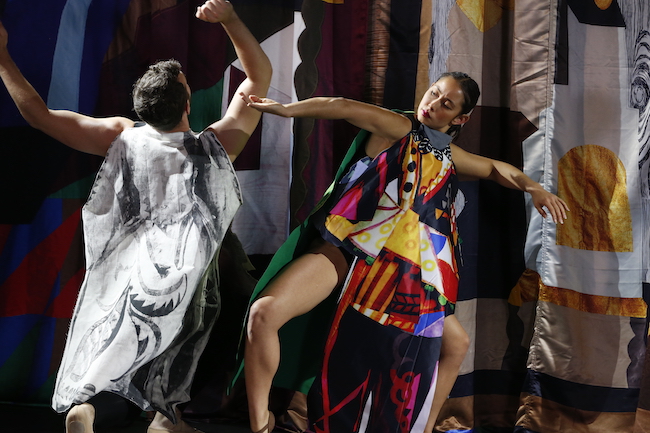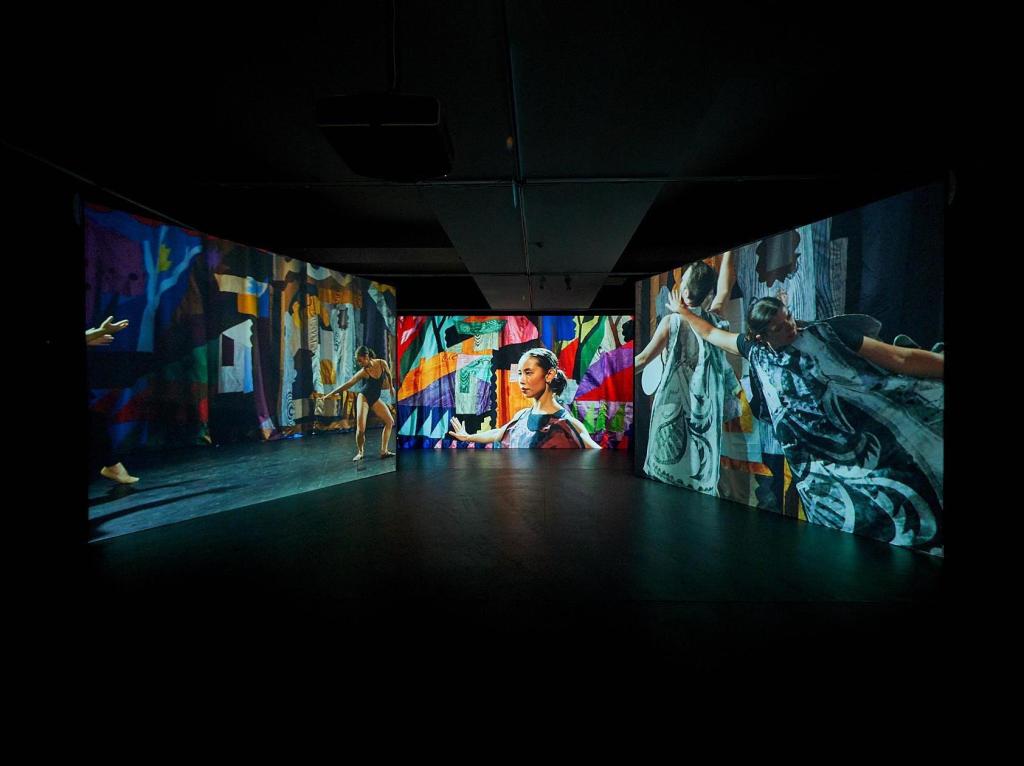Sally Smart, The Violet Ballet (2019), exhibition view, ACE Open. Courtesy the artist and Sarah Scout Presents, Melbourne. Image Sam Roberts Photography
It is often difficult for a performance to translate well in an exhibition space, once that ‘live’ moment has passed and the exhibition continues for another 6-weeks.
For Sally Smart that has presented few problems. Her performative installation The Violet Ballet was staged within the contemporary art venue ACE Open, for the opening week of 2019 Adelaide Festival, using its gong of a ‘world premiere’ to capture a broader audience.
Smart was particularly happy for her work to sit within the Festival alongside the much talked about opera, Barrie Kosky’s The Magic Flute. For both Kosky and Smart, theirs was a kind of “turning inside out” of well-famed productions, offering a new experimental montage of the past.
Smart’s piece for ACE Open, however, goes back well before festival planning, taking its cue from one of Ballets Russes’ most difficult works, Chout (Tale of the Buffoon).
Smart has been working on The Violet Ballet for over four years, connecting her long-held interest in the avant-garde dance company with her love of Indonesian culture, especially the gesture of Wayang or shadow puppet play.
Writer Rachel Frensham makes the point that while Smart’s work might reference a 1920s ballet, it also has a synergy with the fractured reframing of modern life – newspaper headlines to social media today, where images are torn out of context and amplified.
’Collage, in this sense, is an important practice [which] engages us in a simultaneous action of disruption and revelation,’ Frensham writes.
If we are to view Smart’s exhibition in this way, we can be a little more relaxed about not knowing the explicit nuances of Chout – it simply sits beautifully within her oeuvre as an artist with a wide vocabulary of interests and influences.
Smart is best known as an assemblage artist working in a collage. This typically gives her 2-dimensional wall works a sense of multi-dimensionality. For The Violet Ballet she takes that a step further. Essentially, she is assembling in 3-dimensional space – the gesture of a dancer in real time is echoed across video screens, near life-sized puppets and a theatrical curtain ‘cutting up’ the space.
Artist becomes producer; dancer becomes artist; costumes become a screen; a theatre becomes a video – a live performance becomes an exhibition.
Both as a performed work and an exhibition The Violet Ballet had a palpable spatial quality, its informal flow allowing audiences to find their own space in the abstracted narrative.
Entering the gallery, visitors encounter a suite of Smart’s costumes that sit as a prologue to a narrative, puppets caught in frozen action ready to be animated. Their intricate and colourful textiles punching off “Kline-blue” walls – it is an eloquent introduction’ to Smart’s dense poetic world.
, exhibition view, ACE Open. Courtesy the artist and Sarah Scout Presents, Melbourne. Image Sam Roberts Photography 1.jpg)
Sally Smart, The Violet Ballet (2019), exhibition view, ACE Open. Courtesy the artist and Sarah Scout Presents, Melbourne. Image Sam Roberts Photography
Moving deeper into the gallery space, a heavy textile curtain divides the room, offering a dramatic reveal of the main event – a three-channel video – its configuration again echoing formal theatre design of mainstage and wings. It works well.
The film component is 17 minutes – very doable – while the opening performance for the festival was 30 minutes, presented in a free flow format that embedded audience between performed and narrated realities.
However, the “thing” – that weighty, non-visual energy – that stitches The Violet Ballet together is collaboration.
Smart’s embroidery works have been created by digitally cutting up images of the original Ballets Russes costumes designed by Pablo Picasso, Henri Matisse and Sonia Delaunay, a silent collaboration with visual artists who worked in a multi-disciplinary way.
History again adds another layer from an Indonesian perspective. The patterns and styles developed by Mikhail Larionov were embroidered by Indonesian artisans (DGTMB Art Embroidery), who Smart has worked with for many years. They found a familiarity in Larionov’s avant-garde designs, despite coming from Russian folk culture. It is something that Smart also inherently felt in the work’s development.
She told ArtsHub: ‘I only just learnt that Larionov was influenced, and interested in, Indonesian puppetry. He would have seen them through the Dutch taking them to Europe. This was 1915 – it gives me goose bumps – this is new knowledge.’
‘I could feel it in Javanese dance in the way it is all on a flat plane, and my work operates in a similar way in that flat space to the wall. But taking it into a three dimensional space, is essentially how Larionov did it – it was my trigger point.’
What one might imagine as a huge pendulum swing from avant-garde Russian dance to Indonesian wayang (puppet theatre), Smart makes the point it’s a felt experience – this is not an ‘artist performance’ but more about a total immersion. ‘I think cross-cultural relationships, that embed like this, are real and they have always been there and they are profound, and they come out of connection and love of a place,’ she said.
Whether you are literate in dance history and experimental theatre or not, it is not necessary to pick up on that when viewing Smart’s The Violet Ballet. The viewing experience has its own immediate history.
The movement of the four dances – working as a fluid troupe – was totally improvised, and has an enigmatic quality. There was an incredible strength in the gesture of the women, and in particular their movement portraying animals – a horse, a goat – throwing the audience an anchor to grasp in amidst the fantasy and avant-garde fairytales.
It’s complex, yes, but also intriguing for its movement and poetry.

Sally Smart, The Violet Ballet (behind the scenes), (2018). Photo Jeff Busby
Smart told ArtsHub that there is ‘a lot of trust’ in those collaborative relationships. She has worked with choreographer Brooke Stamp for three years; writer Maria Tamakan for nine – the text alone for The Violet Ballet has taken two years, with operatic vocals performed by Billie Tumarkin.
Smart’s son has worked with David Franken on Sergei Prokofiev’s original 1921 score of Chout. Billie Tumarkin’s phenomenal voice tied it all together with a piercing urgency.
Everything about this exhibition offers a slippage of understanding – from past to present, east to west, colonialism to feminism, from visual arts to dance.
Not all the layers in Smart’s work are immediately obvious, or slowly revealed. This is a dense piece of immersive art that reaches into the depths of thought – perhaps in the same way that a dancer’s body carries the memory of history or an artist’s gesture also carries memory – they are slightly unexplanable things, but as viewers in the hands of Smart, we are happy to relinquish a sense of order. We are but moths to a light.
Rating: 4 out of 5
Sally Smart: The Violet Ballet
The Violet Ballet was programmed as part of the 2019 Adelaide Festival
Text / libretto: Maria Tumarkin
Choreography: Brooke Stamp
ACE Open, Adelaide
2 March – 27 April 2019





